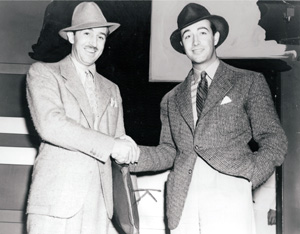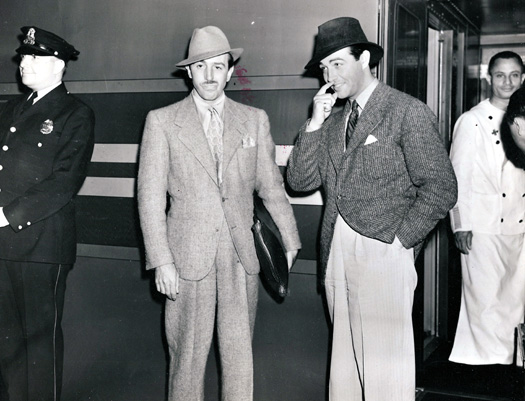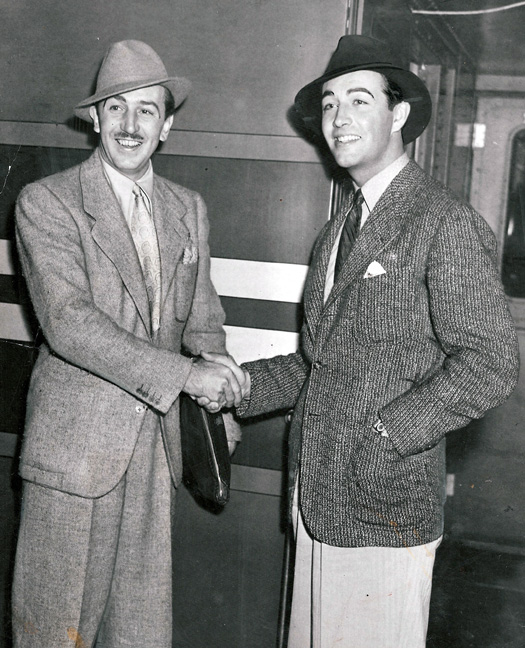
ESSAYS
A Day in the Life: Disney, June 20, 1938
By Michael Barrier
Walt and Lillian Disney arrived in Manhattan by train at 8:55 a.m. on Monday, June 20, 1938. They were on their way to New Haven, Conn., and Cambridge, Mass., where Walt would receive honorary degrees from Yale and Harvard Universities, respectively. Walt was by then, as the producer of Snow White and the Seven Dwarfs, a show-business celebrity of the first order, and so reporters and photographers were waiting.
Unknown to them, there was another Hollywood celebrity on the train: Robert Taylor, the 26-year-old actor who was in the early stages of his long career as an MGM star. "He might have slipped into town undiscovered," the New York Post reported, "except that reporters were on hand to meet Walt Disney, the screen cartoonist, and picked Bob out from behind a pile of luggage on the same train."
Taylor was in town to attend the highly anticipated Joe Louis-Max Schmeling rematch that Wednesday evening, and, not coincidentally, promote his own forthcoming feature about boxing, The Crowd Roars, which would be released in the summer of 1938. The reporters bombarded Taylor with questions about his romance with Barbara Stanwyck, to which he replied repeatedly, "No comment." (They married the next year.)
 As for Walt, the Post described him as "shy as one of the fawns in his own animated cartoons," but he was not so shy as to decline the opportunity to pose with Taylor. The small photo on this page turns up frequently on eBay, as a pretty good scan; the other two photos are from original prints. I particularly like the photo below, in which the two men are obviously waiting for instructions.
As for Walt, the Post described him as "shy as one of the fawns in his own animated cartoons," but he was not so shy as to decline the opportunity to pose with Taylor. The small photo on this page turns up frequently on eBay, as a pretty good scan; the other two photos are from original prints. I particularly like the photo below, in which the two men are obviously waiting for instructions.
Walt and Lilly stayed at the Waldorf-Astoria—they would be in the Northeast for about two weeks altogether, with plans to see lots of Broadway shows—and a reporter for the Post interviewed him there. In the aw-shucks manner that he sometimes adopted, Walt professed himself dazed by the academic honors he was receiving:
"I'm a very uneducated man, a graduate of the school of hard knocks. I went as far as high school and art school in Chicago, but that was all."
He said of Snow White's broad appeal: "I believe it's because the people who work with me, and I myself, are sort of simple in our tastes and ideas. Simple things have the greatest appeal. Snow White has given us a break. Before that, no matter how good our idea, we had to hold it down to one reel. The money we've made from Snow White gives us a chance we wanted for years. It even convinced the bankers."
No longer as shy as a fawn, Walt slipped into hyperbole: "Everything I had went into hock to finance Snow White. I had to mortgage everything I owned, including Mickey Mouse and Donald Duck and everything else. Not until the picture was done were the bankers willing to transfer the loans to Snow White and clear the other properties. It was a $2,900,000 investment."
As to whether he expected Snow White to be such a huge success, he said: "Every time we work on a picture we think it's going to be an epic and when it's finished we think it's lousy. Then we wait and shiver until we see how the public likes it."
It may seem a little strange today that celebrities like Walt Disney and Robert Taylor spent several days crossing the country by train when they visited New York, but that was standard practice in the '30s, when commercial aviation was still establishing itself. Reporters in places like Kansas City would be on the platform when trains passed through on the way from California, ready to corner a celebrity like Walt when he stepped off the train to stretch his legs.
Walt and Robert Taylor undoubtedly crossed paths in Hollywood in later years, and they wound up making one movie together: The Miracle of the White Stallions, which Walt filmed in Europe, with Arthur Hiller as director, and released in 1963. It is, alas, not a high spot in either man's filmography.
June 20, 1938, was, however, an exceptional day not just for Walt but for his employees. That morning, The Hollywood Reporter announced that the Disney studio—which had just adopted a five-day, 40-hour week—would close for a two-week paid vacation in late August and early September. That same day, the studio announced the site for its dazzling new plant in Burbank. For the moment, there was not a cloud on the horizon.

[Posted May 21, 2008]
